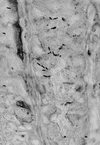Helicobacter cetorum sp. nov., a urease-positive Helicobacter species isolated from dolphins and whales
- PMID: 12454148
- PMCID: PMC154630
- DOI: 10.1128/JCM.40.12.4536-4543.2002
Helicobacter cetorum sp. nov., a urease-positive Helicobacter species isolated from dolphins and whales
Abstract
A novel helicobacter with the proposed name Helicobacter cetorum, sp. nov. (type strain MIT 99-5656; GenBank accession number AF 292378), was cultured from the main stomach of two wild, stranded Atlantic white-sided dolphins (Lagenorhynchus acutus) and from the feces of three captive cetaceans (a Pacific white-sided dolphin [Lagenorhynchus obliquidens]; an Atlantic bottlenose dolphin [Tursiops truncatus]; and a beluga whale [Delphinapterus leucas]). The infected captive cetaceans were either subclinical, or clinical signs included intermittent regurgitation, inappetance, weight loss, and lethargy. Ulcers were observed in the esophagus and forestomach during endoscopic examination in two of the three captive animals. In the third animal, esophageal linear erosions were visualized endoscopically, and histopathological evaluation of the main stomach revealed multifocal lymphoplasmacytic gastritis with silver-stained spiral-shaped bacteria. Helicobacter cetorum is a fusiform gram-negative bacterium with a single bipolar flagellum. The isolates grow under microaerobic conditions at 37 and 42 degrees C but not at 25 degrees C. H. cetorum is urease, catalase, and oxidase positive, and it is sensitive to cephalothin. The isolates from the wild, stranded dolphins were sensitive to nalidixic acid, whereas the isolates from the collection animals were resistant. By 16S rRNA sequencing it was determined that H. cetorum represented a distinct taxon that clusters most closely with H. pylori. Further studies are necessary to determine the role of H. cetorum in the development of gastric ulcers and gastritis of cetaceans. This is the first description and formal naming of a novel Helicobacter species from a marine mammal.
Figures






Similar articles
-
Comparison of diagnostic techniques for Helicobacter cetorum infection in wild Atlantic bottlenose dolphins (Tursiops truncatus).J Clin Microbiol. 2003 Jul;41(7):2842-8. doi: 10.1128/JCM.41.7.2842-2848.2003. J Clin Microbiol. 2003. PMID: 12843010 Free PMC article.
-
Isolation and characterization of a Helicobacter sp. from the gastric mucosa of dolphins, Lagenorhynchus acutus and Delphinus delphis.Appl Environ Microbiol. 2000 Nov;66(11):4751-7. doi: 10.1128/AEM.66.11.4751-4757.2000. Appl Environ Microbiol. 2000. PMID: 11055919 Free PMC article.
-
Helicobacter cetorum infection in striped dolphin (Stenella coeruleoalba), Atlantic white-sided dolphin (Lagenorhynchus acutus), and short-beaked common dolphin (Delphinus delphus) from the southwest coast of England.J Wildl Dis. 2014 Jul;50(3):431-7. doi: 10.7589/2013-02-047. Epub 2014 May 7. J Wildl Dis. 2014. PMID: 24807181
-
Gastric and enterohepatic helicobacters other than Helicobacter pylori.Helicobacter. 2014 Sep;19 Suppl 1:59-67. doi: 10.1111/hel.12162. Helicobacter. 2014. PMID: 25167947 Review.
-
The interplay between social networks and culture: theoretically and among whales and dolphins.Philos Trans R Soc Lond B Biol Sci. 2013 Apr 8;368(1618):20120340. doi: 10.1098/rstb.2012.0340. Print 2013 May 19. Philos Trans R Soc Lond B Biol Sci. 2013. PMID: 23569288 Free PMC article. Review.
Cited by
-
Age of the association between Helicobacter pylori and man.PLoS Pathog. 2012;8(5):e1002693. doi: 10.1371/journal.ppat.1002693. Epub 2012 May 10. PLoS Pathog. 2012. PMID: 22589724 Free PMC article.
-
Nodeomics: pathogen detection in vertebrate lymph nodes using meta-transcriptomics.PLoS One. 2010 Oct 18;5(10):e13432. doi: 10.1371/journal.pone.0013432. PLoS One. 2010. PMID: 20976145 Free PMC article.
-
Evaluation of two commercially available immunological kits for the diagnosis of Helicobacter spp. in bottlenose dolphins (Tursiops truncatus).Curr Microbiol. 2015 May;70(5):685-9. doi: 10.1007/s00284-014-0772-8. Epub 2015 Jan 13. Curr Microbiol. 2015. PMID: 25578177
-
Species of the family Helicobacteraceae detected in an Australian sea lion (Neophoca cinerea) with chronic gastritis.J Clin Microbiol. 2004 Aug;42(8):3505-12. doi: 10.1128/JCM.42.8.3505-3512.2004. J Clin Microbiol. 2004. PMID: 15297490 Free PMC article.
-
Helicobacter pylori-induced gastric pathology: insights from in vivo and ex vivo models.Dis Model Mech. 2017 Feb 1;10(2):89-104. doi: 10.1242/dmm.027649. Dis Model Mech. 2017. PMID: 28151409 Free PMC article. Review.
References
-
- Banatvala, N., C. Romero Lopez, and R. J. Owen. 1994. Use of the polymerase chain reaction to detect Helicobacter pylori in the dental plaque of healthy and symptomatic individuals. Microb. Ecol. Health. Dis. 7:1-8.
-
- Barbosa, A., J. Silva, A. Nogueira, E. Paulino, and C. Miranda. 1995. Higher incidence of Gastrospirillum sp. in swine with gastric ulcer of the pars oesophagea. Vet. Pathol. 32:134-139. - PubMed
-
- Batchelder, M., J. G. Fox, A. Hayward. 1996. Natural and experimental Helicobacter mustelae reinfection following successful antimicrobial eradication in ferrets. Helicobacter 1:34-42. - PubMed
-
- Bury-Mone, S., S. Skouloubris, A. Labigne, and H. De Reuse. 2001. UreI: a Helicobacter pylori protein essential for resistance to acidity and for the early steps of murine gastric mucosa infection. Gastroenterol. Clin. Biol. 25:659-663. - PubMed
-
- Cavallini, A., M. Notarnicola, P. Berloco, A. Lippolis, and A. De Leo. 2000. Use of macroporous polypropylene filter to allow identification of bacteria by PCR in human fecal samples. J. Microbiol. Methods 39:265-270. - PubMed
Publication types
MeSH terms
Substances
Associated data
- Actions
Grants and funding
LinkOut - more resources
Full Text Sources
Medical
Molecular Biology Databases

